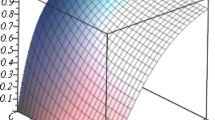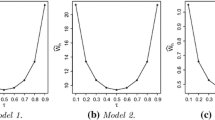Abstract
This paper investigates the estimation of parameters in a multivariate quantile regression model when the investigator wants to evaluate the associated distribution function. It proposes a new directional quantile estimator with the following properties: (1) it applies to an arbitrary number of random variables; (2) it is equivalent to estimating the distribution function allowing for non-convex distribution contours; (3) it satisfies nice equivariance properties; (4) it has desirable statistical properties (i.e., consistency and asymptotic normality); and (5) its implementation involves a modest computational burden: our proposed estimator can be obtained by solving parametric linear programming problems. As such, this paper expands the range of applications of quantile estimation for multivariate regression models.


Similar content being viewed by others
Notes
For example, Hallin et al. (2010) proposed a directional quantile estimator involving hyperplanes that define halfspace Tukey-depth level sets.
Note that multivariate unconditional quantiles are obtained as a special case when \(k=1\) and \(x=1\).
An extreme point in a convex set is a point that cannot be expressed as a convex combination of any other points in the set.
With (\(v_L,v_M)\) as bounds on simulated \(v_2 \), choosing \(y_2 =\frac{v_2-v_L }{v_M-v_L }\in [0,1]\) means that the distribution of \(Y_2 \) is a truncated version of the distribution of \(V_2 \), with truncation effects that vary with the simulated sample. As a result, we do not have a closed-form expression for the joint distribution of \((Y_1,Y_2)\). In this context, the quantile estimates reported below have the simple objective of illustrating that our proposed estimator is empirically tractable.
References
Billingsley P (1986) Probability and measure. Wiley, New York
Cai Y (2010) Multivariate quantile function models. Stat Sin 20:481–496
Chaudhuri P (1996) On a geometric notation of quantiles for multivariate data. J Am Stat Assoc 91:862–872
Chernozhukov V, Galichon A, Hallin M, Henry N (2017) Monge–Kantorovich depth, quantiles, ranks and signs. Ann Stat 45:223–256
El Bantli F, Hallin M (1999) L\(_{1}\) estimation in linear models with heterogeneous white noise. Stat Probab Lett 45:305–315
Hallin M, Paindaveine D, Šiman M (2010) Multivariate quantiles and multi-output regression quantiles: from L\(_{1}\) optimization to halfspace depth. Ann Stat 38:635–668
Huber PJ (1964) Robust estimation of a location parameter. Ann Math Stat 35:73–101
Koenker R (2005) Quantile regression. Cambridge University Press, Cambridge
Koenker R, Bassett G (1978) Regression quantile. Econometrica 46:33–50
Kong L, Mizera I (2012) Quantile tomography: using quantiles with multivariate data. Stat Sin 22:1589–1610
Knight K (1998) Limiting distributions for L\(_{1}\) regression estimators under general conditions. Ann Stat 96:755–770
Manski CF (1988) Analog estimation methods in econometrics. Chapman and Hall, New York
Mizera I, Wellner JA (1998) Necessary and sufficient conditions for weak consistency of the median of independent but not identically distributed random variables. Ann Stat 26:672–691
Serfling R (2010) Equivariance and invariance properties of multivariate quantile and related functions and the role of standardization. J Nonparametr Stat 22:915–936
Serfling R, Zuo Y (2010) Discussion. Ann Stat 38:676–684
Tukey JW (1974) Mathematics and the picturing of of data. In: Proceedings of the International Congress of Mathematicians, vol 2, Vancouver, BC, pp 523–531
Wei Y (2008) An approach to multivariate covariate-dependent quantile contours with application to bivariate conditional growth charts. J Am Stat Assoc 103:397–409
Author information
Authors and Affiliations
Corresponding author
Additional information
The author would like to thank two reviewers for useful comments on an earlier draft of the paper.
Rights and permissions
About this article
Cite this article
Chavas, JP. On multivariate quantile regression analysis. Stat Methods Appl 27, 365–384 (2018). https://doi.org/10.1007/s10260-017-0407-x
Accepted:
Published:
Issue Date:
DOI: https://doi.org/10.1007/s10260-017-0407-x




